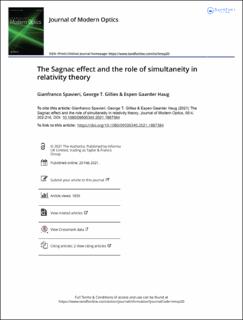| dc.contributor.author | Spavieri, Gianfranco | |
| dc.contributor.author | Gillies, George T. | |
| dc.contributor.author | Haug, Espen | |
| dc.date.accessioned | 2022-03-08T09:45:58Z | |
| dc.date.available | 2022-03-08T09:45:58Z | |
| dc.date.created | 2021-02-20T20:26:54Z | |
| dc.date.issued | 2021 | |
| dc.identifier.citation | Journal of Modern Optics. 2021, 68 (4), 202-216. | |
| dc.identifier.issn | 0950-0340 | |
| dc.identifier.uri | https://hdl.handle.net/11250/2983697 | |
| dc.description.abstract | We thoroughly examine the role of absolute and relative simultaneity in the interpretation of the Sagnac effect, using an approach that allows for determining the local speed along the light path. If the local speed of light is assumed to be c over the whole closed contour, there is no agreement with the observed result. There is agreement if the local speed is c along an open section of the contour only. Thus a rigorous and coherent interpretation of the Sagnac effect favours absolute over relative simultaneity. The implications for the Lorentz transformations and synchronization by means of the Global Positioning System are considered. | |
| dc.language.iso | eng | |
| dc.title | The Sagnac effect and the role of simultaneity in relativity theory | |
| dc.type | Peer reviewed | |
| dc.type | Journal article | |
| dc.description.version | publishedVersion | |
| dc.source.pagenumber | 202-216 | |
| dc.source.volume | 68 | |
| dc.source.journal | Journal of Modern Optics | |
| dc.source.issue | 4 | |
| dc.identifier.doi | 10.1080/09500340.2021.1887384 | |
| dc.identifier.cristin | 1892047 | |
| cristin.ispublished | true | |
| cristin.fulltext | original | |
| cristin.qualitycode | 1 | |
